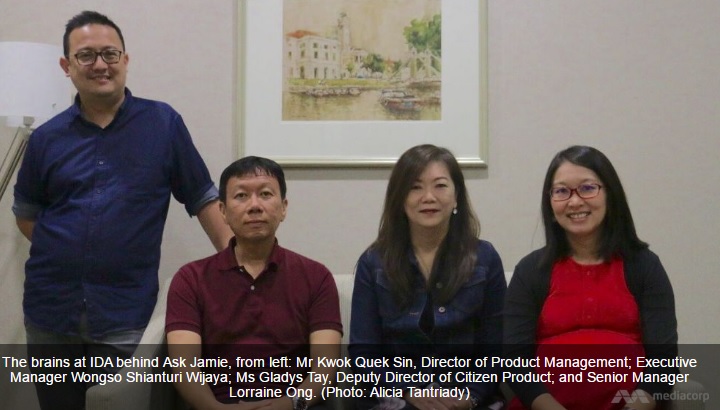The team behind virtual assistant Ask Jamie started off its development trail in 2014 with a simple premise: How do we improve citizens’ experience when utilising e-Government services, and can we automate the process? (ChannelNewsAsia Report)
Ms Gladys Tay, Deputy Director of Citizen Product at the Infocomm Development Authority of Singapore (IDA), said that in the past few years, the team had observed that public queries were on the rise. In fact, during the 2009 to 2012 period, queries and searches on Government websites’ Frequently Asked Questions (FAQs) section tripled.
They also found that many of these search queries are general questions with answers readily available.
This prompted the team — comprising Ms Tay, as well as Director of Product Management Kwok Quek Sin, Senior Manager Lorraine Ong and Executive Manager Wongso Shianturi Wijaya – in January 2014 to award a tender to a vendor to help build Ask Jamie for Government agencies to give it a go.
Within months, the Singapore Land Authority (SLA) and Unique Entity Number (UEN), the portal housing the identity numbers for businesses in Singapore, became the first two agencies to implement Ask Jamie in May, IDA revealed.
According to the team, some of the more interesting questions the virtual assistant had to field ranged from “Are you real?” and “How did you type so fast?” to “Will you go out on a date with me?” However, over time, the usefulness of the virtual assistant outstripped the novelty factor: Relevancy scores — how relevant an answer given via Ask Jamie to the question asked — rose to more than 80 per cent. Additionally, of the users who proceeded to fill in the feedback form at the end of their chat session, more than 60 per cent said using the service helped save them a call to that particular Government body.
One way the virtual assistant looks to amp up its usefulness to citizens is the ability to pull and display information from one Government agency, even though the query was placed on a separate agency. For instance, someone can ask about Primary 1 registration on the SLA website, despite the information being housed on the Ministry of Education’s portal, Ms Tay explained. To date, nine Government websites have implemented Ask Jamie, and Mr Kwok said the team is hoping to have 20 on board by the end of the year.
Mr Kwok said the name Jamie came about as the team wanted one that is “simple to remember, friendly and personable”, unlike some of the acronyms coined by the Government in the past. As for the avatar, the team adopted a similar mindset of wanting a professional, yet friendly and approachable presence as the face of its virtual assistant. Eventually, after searching various image databases, they decided on the current iteration. “Coincidentally, she also looks a lot like one of our colleagues,” revealed Mr Kwok.
Not resting on their laurels, his team is constantly working with the third-party vendor to introduce features that might improve one’s experience engaging with the Government. One example is for the virtual assistant to automatically direct, or “escalate”, a person’s query after three tries to a live chat, where someone can address the question in person, he said.
The feature is available, but it has not been deployed to any website yet, Mr Kwok added.
He also said that the team is exploring the idea of integrating third-party knowledge databases such as WolframAlpha to add value to a citizen’s online experience, but acknowledged that this was not a core function of Ask Jamie.
Looking forward, he also shared that his team is working concurrently on a chatbot internally, as an extension of Ask Jamie on conventional PCs and laptops. Mr Kwok said that based on personal experience, there is a segment of the population that may be more comfortable in a mobile chat environment compared with other communication platforms like emails. He shared that Mr Wongso had approached him in April this year, showing the bare bones coding framework to build the chatbot. Channel NewsAsia was given a sneak peek of the bot’s functionalities, which resembled the Quartz news app in that each query would prompt several options and users’ choices would result in different replies. The difference between this chatbot and Ask Jamie is that the former will have a “context-sensitive engine” so that it is better able to understand a user’s query when it is ambiguous, said Mr Kwok. For instance, if a citizen uses “P1” in the question, the engine should understand whether the user is asking about Primary 1 registration or Phase 1 of a development project, he said.
In terms of use cases, Mr Kwok said nothing is concrete yet. But hypothetically speaking, the chatbot could include transactional capabilities that would allow a Singaporean male to carry out an overseas notification on his smartphone on the fly, without having to go through the NS.sg portal. There is no timeframe set for the chatbot to be rolled out, but the IDA executive said that it would continue to be developed internally. Read more


